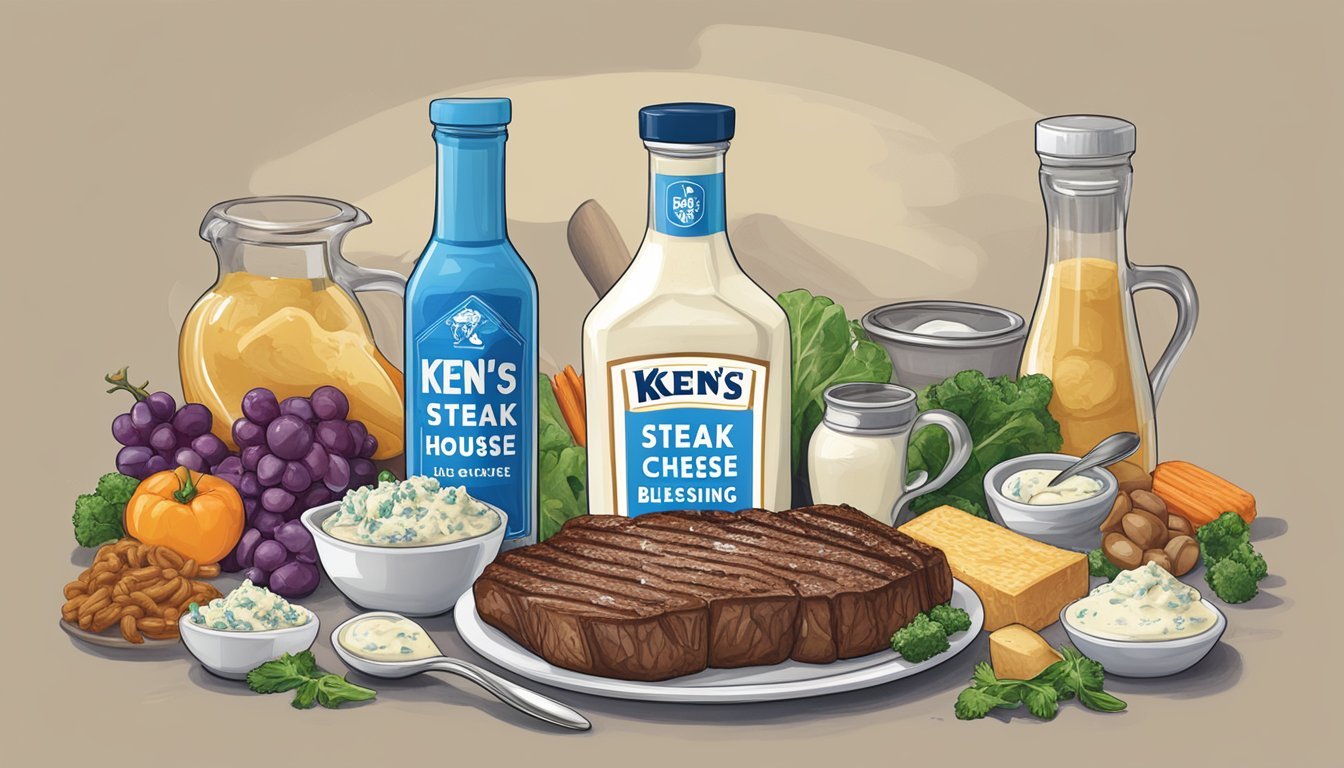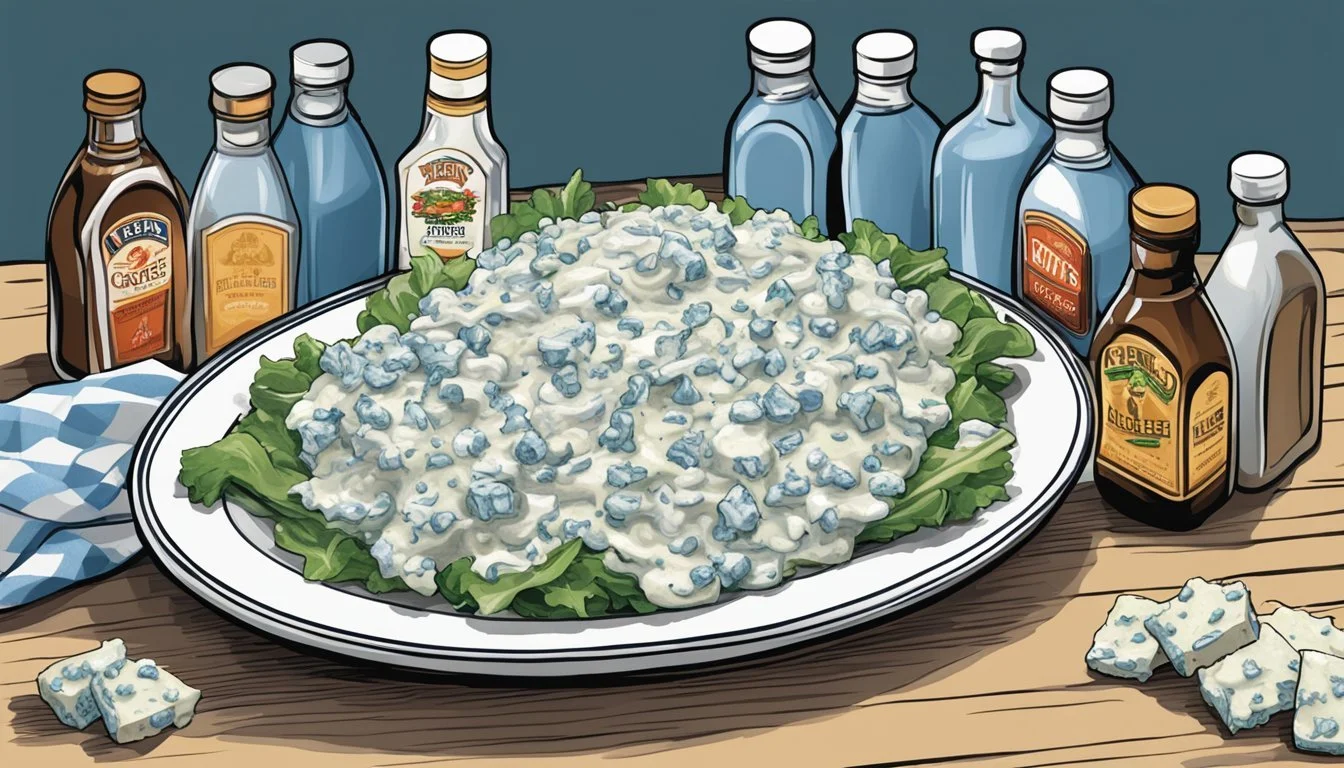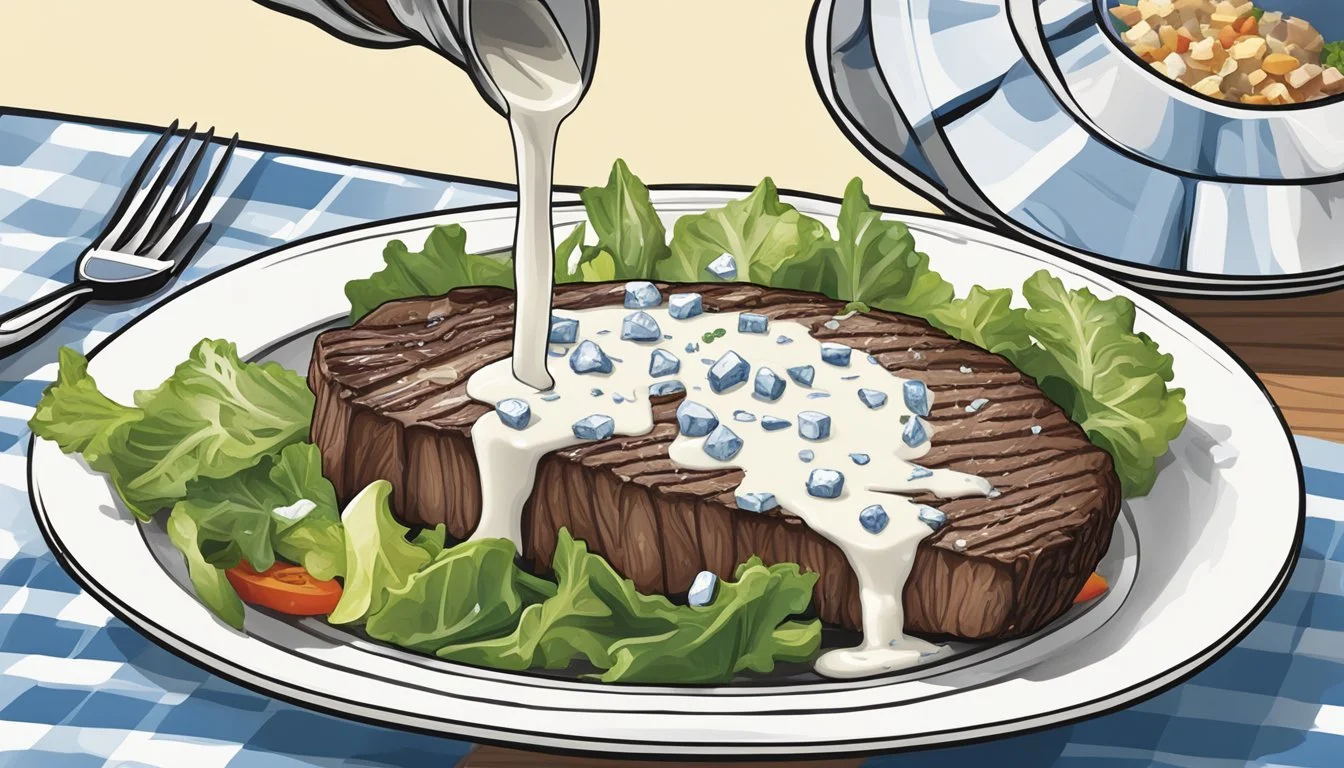How Much Ken's Steak House Blue Cheese Dressing Per Day Is Unhealthy
Portion Guidelines
Determining the appropriate amount of Ken's Steak House blue cheese dressing to consume daily is a matter of balancing taste preferences with nutritional guidelines. Ken's Steak House, a brand known for its variety of dressings, offers blue cheese dressing that is rich in flavor and, like many dressings, in calories and fat. A serving of their regular blue cheese dressing contains 310 calories and 32 grams of fat, while the lite version has 80 calories and 8 grams of fat per serving. These values signify a significant portion of the recommended daily intake, especially for individuals who are mindful of their calorie and fat consumption.
When considering the daily consumption of blue cheese dressing, it's imperative to assess its nutritional content in the context of an overall diet. The saturated fat content in a single serving of Ken's blue cheese dressing is generally high, which can be of concern if consumed in excess because it can contribute to an increased risk of heart disease. Additionally, the dressing contains sodium, which in large quantities can lead to an increase in blood pressure. Therefore, moderation is key, and incorporating the dressing into a well-balanced diet is essential.
While blue cheese dressing can enhance the taste of salads and other dishes, it should be used judiciously to maintain a healthy dietary pattern. Individuals should aim to align their dressing intake with their nutritional goals and dietary needs, taking into account other sources of fat and sodium in their diet. As a flavor enhancer, Ken's Steak House blue cheese dressing can be a part of a diverse and nutritious diet when used in controlled amounts.
Nutritional Overview
Ken's Steak House Blue Cheese Dressing varies in calorie content and nutritional composition across different varieties. The standard version carries about 200 calories per 1.5 ounces (43g) serving. The nutrition is predominantly made up of fats, with 94% fat, minimal carbohydrate, and protein content.
A typical serving size for salad dressings like Ken's Blue Cheese is 2 tablespoons (30g). Within this common serving size, the lite version is notably lower in calories, providing only about 80 calories, with 8g of total fat. Regular varieties have higher calorie counts, with a serving containing up to 310 calories and 32g of total fat.
The fat content includes both saturated and trans fats, with the saturated fat content being 2.5g per serving in some versions, equating to around 13% of the daily value. Trans fat is generally not present, while cholesterol levels vary, with some types having 0mg and others up to 10mg per serving.
Sodium is also a consideration, with levels around 290mg to 360mg, which is about 13% to 16% of the daily value. Carbohydrates are mostly low, with 1g to 2g per serving. These dressings are not significant sources of dietary fiber, sugars, or protein, and contain little to no Vitamin D, calcium, potassium, Vitamin A, Vitamin C, or iron.
Nutrient Amount Per Serving (Regular) % Daily Value* Calories 310 - Total Fat 32g - Saturated Fat 2.5g 13% Trans Fat 0g 0% Cholesterol 0-10mg 0-3% Sodium 290-360mg 13-16% Total Carbohydrates 1-2g <1% Dietary Fiber 0g 0% Sugars 1g - Protein 0g 0%
Consumers should check labels for exact figures as ingredients and nutritional content can vary by product. It is always wise to consider the context of an entire diet when determining appropriate serving sizes.
Dietary Recommendations
When considering the consumption of Ken's Steak House blue cheese dressing, one must adhere to daily intake guidelines and understand the Recommended Dietary Intakes (RDIs) to maintain a balanced diet.
Daily Intake Guidelines
The consumption of Ken's Steak House blue cheese dressing should align with the general dietary guidelines for fats and sodium. A person engaging in moderate effort activities typically has a caloric threshold that can accommodate discretionary calories from dressings. For those on a weight loss effort or strict diet regimen, it is advised to monitor the intake of such dressings more closely. Here's a breakdown of the nutritional content in a typical serving size:
Calories: 200 per 1.5-ounce serving
Total Fat: 21 grams
Sodium: 360 milligrams
Considering these values, a responsible daily limit could be one serving of dressing, to keep within dietary fat and sodium allowances.
Understanding RDIs
RDIs are a set of dietary references based on the nutritional intake of healthy people. They are used to assess and plan diets. The RDI for total fat for an average adult is 20-35% of caloric intake, while for sodium it is less than 2,300 milligrams. Here's how the dressing's nutritional content measures up:
Total Fat: At 21 grams per serving, it accounts for a significant portion of the RDI for fat.
Sodium: With 360 milligrams per serving, it represents a notable part of the RDI for sodium.
Individuals should carefully consider these figures when adding Ken's Steak House blue cheese dressing to their meals, ensuring it doesn't cause them to exceed RDIs. This is especially important for those with special dietary needs or medical conditions requiring limited fat or sodium intake.
Health Considerations
When including Ken's Steak House blue cheese dressing in one's diet, it is crucial to consider its content of sodium, fats, and carbohydrates. These components can impact health, particularly when consumed in excessive amounts.
Identifying High Sodium
Ken's Steak House blue cheese dressings contain varying amounts of sodium. For instance, one serving of their standard blue cheese dressing provides 290mg of sodium which is roughly 13% of the daily recommended intake based on a 2,000-calorie diet. Excessive sodium intake can lead to increased blood pressure and heart disease risk. Consumers should aim to not exceed the American Heart Association’s recommendation of no more than 2,300 milligrams a day and ideally move toward an ideal limit of no more than 1,500 mg per day for most adults.
Managing Fat Intake
Saturated fat and monounsaturated fat are present in significant amounts in blue cheese dressing. It's important to monitor the fat content, as high intake of saturated fat, in particular, can be linked to higher cholesterol levels and heart disease risk. For example, the Lite version of the dressing offers 1.5g of saturated fat per serving, while the regular dressing contains 6g. Remaining mindful of the trans fat content, which fortunately is 0g in these dressings, is also important as trans fats are detrimental to heart health.
Balancing Carbohydrates
Carbohydrates in the form of sugars and added sugars are present in Ken's blue cheese dressings. Although the carbohydrate content is not high, with the regular version containing 1g of carbohydrates and the Lite version containing 2g per serving, these still contribute to one's overall daily carbohydrate intake. For individuals managing net carb intake, it's noteworthy that the fiber content in these dressings is non-significant, effectively making the total carbohydrate count equivalent to the net carbs. Monitoring sugar intake, especially added sugars, is essential for maintaining a healthy diet, particularly for those with concerns about blood sugar levels.
Comparative Analysis
When considering the consumption of Ken's Steak House blue cheese dressing, it is important to understand how it compares to other dressings in terms of caloric content, alternative options, and the difference between full fat and reduced fat varieties.
Ken's Versus Other Brands
Ken's Steak House blue cheese dressing contains 200 calories per 1.5 oz serving with a fat content that accounts for 94% of those calories. This is notably higher in calories and fat when compared to certain brands offering lighter alternatives. For example, Skinnygirl Asian Sesame Ginger Salad Dressing presents a much lower caloric option for those seeking healthier alternatives.
Comparison Table:
Dressing Brand Calories Per Serving Total Fat Ken's Blue Cheese 200 94% Skinnygirl Asian Under 10 Negligible
Low Calorie Options
Consumers looking to reduce their calorie intake might opt for dressings like Simple Truth Organic Rosemary Balsamic Dressing or Chick-fil-A Creamy Salsa Dressing. These introduce more diverse palate options while keeping calorie counts much lower than traditional blue cheese dressings.
Low Calorie Picks:
Simple Truth Organic Rosemary Balsamic Dressing
Chick-fil-A Creamy Salsa Dressing
Full Fat Versus Reduced Fat
For those disinclined to opt for a low calorie dressing but still conscious of their dietary intake, Ken's offers a reduced fat version of their chunky blue cheese dressing, clocking in at 80 calories per serving with 8 grams of total fat. In comparison, the full fat option provides a higher caloric content, making the reduced fat version a better choice for those monitoring their daily calorie consumption.
Fat Content Analysis:
Dressing Type Calories Per Serving Total Fat Full Fat Blue Cheese 200 94% Reduced Fat Blue Cheese 80 10%
By considering these comparisons, individuals can make an informed decision about how much Ken's Steak House blue cheese dressing to consume in relation to their dietary goals.
Consumption and Exercise
Careful consideration of caloric intake and physical activity is essential when determining how much Ken's Steak House blue cheese dressing one might consume without exceeding daily nutritional needs.
Physical Activity Pairing
An individual's exercise routine significantly affects how many calories they expend, thus influencing how much blue cheese dressing can be consumed as part of a balanced diet. For instance, a 150-pound adult engaged in moderate-paced walking burns approximately 95 calories per mile walked. This would translate to an estimated 17 minutes per mile when traveling at a moderate pace.
Activity Calories Burned per Hour Equivalent Dressing Serving Walking (17 min/mi) 211 ~2.6 tablespoons Weight Training 224 ~2.8 tablespoons Cycling (18 mph) 864 ~10.8 tablespoons Running Stairs 819 ~10.2 tablespoons Running (10 min/mi) 600 ~7.5 tablespoons
The table above provides a basic guideline for how much exercise is required to burn off calories from Ken's Steak House blue cheese dressing. It assumes no significant wind resistance or incline that would alter the intensity of the workouts listed. For accurate application, individuals should adjust calculations based on their specific circumstances and caloric needs.
Food Database Utilization
When assessing how much Ken's Steak House blue cheese dressing is appropriate for daily consumption, food databases are invaluable tools. These databases operate as calorie counters and repositories for nutritional information of recently popular foods and classic favorites, allowing users to make informed dietary choices.
Food search functions within these databases enable individuals to look up specific items like Ken's blue cheese dressing. The following table illustrates how nutritional data can guide daily intake limits:
Nutritional Component Quantity per 43g Serving % Daily Value* Calories 200 - Total Fat 21g 27% Saturated Fat 4g 20% Total Carbohydrates - 4% Protein - 2%
*Percent Daily Values are based on a 2,000 calorie diet. Your daily values may be higher or lower depending on your calorie needs.
Databases may offer breakdowns of macronutrient components in pie chart representations to visually communicate the fat, protein, and carbohydrate content. For Ken's Steak House blue cheese dressing, the fat content is notably high at 94% of the caloric intake.
Users may find variance in nutritional content for different product lines or serving sizes, thus it is crucial to verify they are referencing the correct version. For instance, the nutritional profile of a reduced-fat or "lite" version will differ significantly from the regular product.
In summary, food databases equip consumers with detailed nutritional insights, serving as a guide to manage and moderate their dressing intake according to their dietary goals and restrictions.
Legal Aspects
When discussing the consumption limits of Ken's Steak House blue cheese dressing, one must consider the legal aspects, specifically those relating to trademarks and intellectual property rights.
Trademark Information
Ken's Steak House blue cheese dressing is a trademarked product, which means the brand name is legally protected. The trademark ensures that Ken's Foods, Inc. has the exclusive rights to use the name for marketing and selling the dressing. Unauthorized use of this trademark can result in legal consequences.
Trademarks are a sort of intellectual property that distinguishes the goods or services of one company from those of others. Ken's trademark prevents confusion in the marketplace and protects consumers by ensuring that they can identify genuine Ken's Steak House blue cheese dressing.
Additionally, copyright laws protect the unique formulations, packaging, advertising slogans, and images associated with Ken's Steak House blue cheese dressing. These elements are the intellectual property of the manufacturer and cannot be reproduced without permission.
Conclusion
When considering the consumption of Ken's Steak House Blue Cheese dressing, individuals should be vigilant about the caloric intake and the fat content. A serving of this dressing contains 200 calories and 21 grams of total fat, which is 27% of the Daily Value based on a 2,000-calorie diet.
To maintain a balanced diet, it is advisable to limit the dressing to a small portion, such as one tablespoon per meal, ensuring it complements rather than dominates the nutritional profile of the dish. Furthermore, it is important to factor in personal dietary needs and any advice from healthcare providers.
Incorporating a variety of dressings and being mindful of portions supports a healthier dietary pattern. For a lower calorie option, one could consider Ken's Lite Chunky Blue Cheese Dressing, which offers 80 calories and 8 grams of fat per serving.
Always be conscious of the sodium content as well; a single serving of the regular blue cheese dressing contains 360mg of sodium. Consistent monitoring and moderation of high-calorie and high-fat foods contribute to an overall balanced diet and may prevent excessive calorie consumption.









